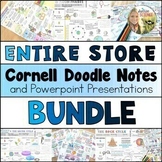Physical Science Doodle Notes Matter Energy Atoms Reactions Waves Motion Forces
- Zip
What educators are saying
Products in this Bundle (28)
showing 1-5 of 28 products
Also included in
- This is a growing bundle of ALL of my Science Cornell Doodle Notes resources. This bundle currently contains Cornell Doodle Notes and the associated Powerpoint / Google Slides Presentations for 48 science topics. The price at this point reflects what is in the bundle at this time, plus 20% off. As aPrice $151.20Original Price $244.25Save $93.05
Description
This is a growing bundle of all of my Physical Science Cornell Doodle Notes. This resource currently contains Cornell Doodle Notes and the associated Powerpoint / Google Slides Presentations for Physical Science 28 topics. The price at this point reflects only what is in the bundle at this time, plus 20% off. As an additional resource is added, the price of this bundle will rise accordingly.
✨ If you buy this bundle today, you are receiving over 20% off on the current resources, plus you will receive all future Physical Science Cornell Doodle Notes for free!
✨ Please view the PREVIEW for more visuals of these resources!
Here are some things to know about Cornell Doodle Notes:
✓ A Powerpoint comes with each of these notes, and it is also available as a Google Slides presentation so that you can opt to share it with your students via Google Classroom
✓ Each set of notes also has a Sum It Up section or practice page to help students engage further with the information in the notes
✓ Each of the notes sets are scaffolded for two or three different levels (same content, different amounts of writing)
✓ Packed with visuals, examples, and analogies for brain-friendly learning
✓ No prep other than printing out the scaffolded note versions and sharing the Google link if necessary
✓ Easy to leave for a substitute
✓ Fun for students to color, which will help to aid retention of the content
✓ Supplements three-dimensional learning with rich content
Distance Learning Digital Note-taking Options:
- Most of the note sets now included a Google Slides version, which includes student directions and Google Tools and Fonts in a sidebar; easy to assign in Google Classroom (if the set hasn't been updated with this feature yet, it will be soon... but you still have the digital note-taking option below!)
- Assign scaffolded PDF version using Kami browser extension (Learn about this option by downloading THIS FREEBIE!)
Topics Currently Included:
Metric System
Measuring Length, Volume, and Mass
Experimental Design & Scientific Method
Energy Forms and Transformations
Heat, Temperature, and Heat Transfer
Elements, Compounds, and Mixtures
The Periodic Table
The Atom
Modeling Atoms
Phase Changes and Energy of Matter
Density
Boiling Point
Gas Laws and Behavior
Endothermic and Exothermic Processes
Valence Electrons
Ions and Ionic Bonding
Covalent Bonding
Balancing Chemical Equations
Chemical Reactions
Nuclear Fusion and Fission
Radioactive Decay
Mechanical Waves
Electromagnetic Waves and Spectrum
Speed and Velocity
Acceleration
Forces
Gravity and Weight
Newton's Laws of Motion
I also have a similar growing bundle that contains only the Chemistry topics!
AND if you are interested in all of the resources in this bundle PLUS labs, manipulatives, projects, and more, please check out my BIG Physical Science Bundle!
You will receive notices under your My Purchases when a new resource is added to this bundle. If you Follow Me you will also receive an email from TPT when this bundle is updated.
✨ You may also be interested in these Cornell Doodle Notes Bundles:
ENTIRE STORE of Cornell Doodle Notes Bundle
Earth and Space Science Cornell Doodle Notes Bundle
Earth Science Cornell Doodle Notes Bundle
Chemistry Topics Cornell Doodle Notes Bundle
Please note that these resources are not editable due to font and clip art licensing agreements. Also, if you plan to share this resource with a group of teachers, that's awesome! But, please purchase additional licenses!
Doodle notes is a trademarked term used with permission. Please visit doodlenotes.org for more information.
Thank you for looking!
Sunrise Science






